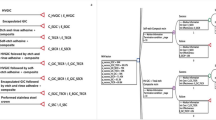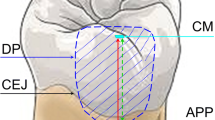Abstract
Objectives
The aim of this study was to evaluate the transdentinal cytotoxicity of components released from different resin-based luting cements to cultured MDPC-23 odontoblast-like cells and human dental pulp cells (HDPCs).
Materials and methods
Artificial pulp chamber (APC)/dentin disc sets were distributed into four groups according to the materials tested (n = 10), as follows: G1, control (no treatment); G2, resin-modified glass-ionomer cement (RelyX Luting 2); G3, self-adhesive resin cement (RelyX U200); and G4, conventional resin cement (RelyX ARC). The materials were applied to the occlusal surfaces (facing up) of the dentin discs adapted to the APCs. The pulpal surfaces of the discs were maintained in contact with culture medium. Then, an aliquot of 400 μL from the extract (culture medium + resin-based components that diffused through dentin) of each luting cement was applied for 24 h to HDPCs or MDPC-23 cells previously seeded in wells of 24-well plates. Cell viability analysis was performed by the MTT assay (1-way ANOVA/Tukey test; α = 5 %).
Results
For MDPC-23 cells, RelyX ARC (G4) and RelyX Luting 2 (G2) caused greater reduction in cell viability compared with the negative control group (P < 0.05). Only the HDPCs exposed to RelyX ARC (G4) extract showed a tendency toward viability decrease (9.3 %); however, the values were statistically similar to those of the control group (G1) (P > 0.05).
Conclusions
In accordance with the safe limits of ISO 10993-5:1999 (E) recommendations, all resin-based luting cements evaluated in this study can be considered as non-toxic to pulp cells.
Clinical relevance
Cytotoxicity of resin-based luting cements is material-dependent, and the different protocols for the application of these dental materials to dentin may interfere with their cytotoxicity.

Similar content being viewed by others
References
De Souza Costa CA, Ribeiro APD, Giro EMA, Randall RC, Hebling J (2011) Pulp response after application of two resin modified glass ionomer cements (RMGICs) in deep cavities of prepared human teeth. Dent Mater 27:158–170. doi:10.1016/j.dental.2011.04.002
Costa CA, Teixeira HM, Nascimento AB, Hebling J (2000) Biocompatibility of two current adhesive resins. J Endod 26:512–516. doi:10.1097/00004770-200009000-00006
De Souza Costa CAS, Nascimento ABL, Teixeira HM (2002) Response of human pulps following acid conditioning and application of a bonding agent in deep cavities. Dent Mater 18:543–551. doi:10.1016/S0109-5641(01)00089-6
Lanza CRM, de Souza Costa CA, Furlan M, Alécio A, Hebling J (2009) Transdentinal diffusion and cytotoxicity of self-etching adhesive systems. Cell Biol Toxicol 25:533–543. doi:10.1007/s10565-008-9110-x
Lessa FCR, Nogueira I, Huck C, Hebling J, de Souza Costa CA (2010) Transdentinal cytotoxic effects of different concentrations of chlorhexidine gel applied on acid-conditioned dentin substrate. J Biomed Mater Res B Appl Biomater 92:40–47. doi:10.1002/jbm.b.31487
Lessa FCR, Nogueira I, Vargas FSV, Spolidorio DMP, Hebling J, de Souza Costa CA (2010) Direct and transdentinal antibacterial effects of chlorhexidine. Am J Dent 23:255–259
Bianchi L, Ribeiro AP, de Oliveira Carrilho MR, Pashley DH, de Souza Costa CA, Hebling J (2013) Transdentinal cytotoxicity of experimental adhesive systems of different hydrophilicity applied to ethanol-saturated dentin. Dent Mater 29:980–990. doi:10.1016/j.dental.2013.07.006
de Souza Costa CA, Hebling J, Randall RC (2006) Human pulp response to resin cements used to bond inlay restorations. Dent Mater 22:954–962. doi:10.1016/j.dental.2005.10.007
Özcan M, Mese A (2012) Adhesion of conventional and simplified resin-based luting cements to superficial and deep dentin. Clin Oral Invest 16:1081–1088. doi:10.1007/s00784-011-0594-z
Pashley DH (1994) Dentine permeability and its role in the pathobiology of dentine sensitivity. Arch Oral Biol 39:73S–80S. doi:10.1016/0003-9969(94)90191-0
Pashley DH (1996) Dynamics of the pulpo-dentin complex. Crit Rev Oral Biol Med 7:104–133. doi:10.1177/10454411960070020101
Ulker HE, Sengun A (2009) Cytotoxicity evaluation of self-adhesive composite resin cements by dentin barrier test on 3D pulp cells. Eur J Dent 3:120–126
Yasuda Y, Inuyama H, Maeda H, Akamine A, Nör JE, Saito T (2008) Cytotoxicity of one-step dentin-bonding agents toward dental pulp and odontoblast-like cells. J Oral Rehabil 35:940–946. doi:10.1111/j.1365-2842.2008.01885.x
Wataha JC (2012) Predicting clinical biological responses to dental materials. Dent Mater 28:23–40. doi:10.1016/j.dental.2011.08.595
Goldberg M (2008) In vitro and in vivo studies on the toxicity of dental resin components: a review. Clin Oral Investig 12:1–8. doi:10.1007/s00784-007-0162-8
Oliveira SS, Pugach MK, Hilton JF, Watanabe LG, Marshall SJ, Marshall Jr GW (2003) The influence of the dentin smear layer on adhesion: a self-etching primer vs. a total-etch system. Dent Mater 19:758–767. doi:10.1016/S0109-5641(03)00023-X
Reis A, Grandi V, Carlotto L, Bortoli G, Patzlaff R, Rodrigues Accorinte ML, et al. (2005) Effect of smear layer thickness and acidity of self-etching solutions on early and long-term bond strength to dentin. J Dent 33:549–559. doi:10.1016/j.jdent.2004.12.003
International Organization for Standardization: ISO 10993-5:1999 (E) (1999) Biological evaluation of medical devices - Part 5: Tests for in vitro cytotoxicity, 2nd edn. ISO, Géneve
Pontes EC, Soares DG, Hebling J, de Souza Costa CA (2014) Cytotoxicity of resin-based luting cements to pulp cells. Am J Dent 27:237–344
Araujo PHH, Sayer C, Poco JGR, Giudici R (2002) Techniques for reducing residual monomer content in polymers: a review. Polym Eng Sci 42:1442–1448. doi:10.1002/pen.11043
Radovic I, Monticelli F, Goracci C, Vulicevic ZR, Ferrari M (2008) Self-adhesive resin cements: a literature review. J Adhes Dent 10:251–258
Makkar S, Malhotra N (2013) Self-adhesive resin cements: a new perspective in luting technology. Dent Update 40:758–760
Eliades G, Vougiouklakis G, Palaghias G (2001) Heterogeneous distribution of single-bottle adhesive monomers in the resin-dentin interdiffusion zone. Dent Mater 17:277–283. doi:10.1016/S0109-5641(00)00082-8
Cadenaro M, Breschi L, Rueggeberg FA, Agee K, Di Lenarda R, Carrilho M, Tay FR, Pashley DH (2009) Effect of adhesive hydrophilicity and curing time on the permeability of resins bonded to water vs. ethanol-saturated acid-etched dentin. Dent Mater 25:39–47. doi:10.1016/j.dental.2008.05.004
Ye Q, Park J, Parthasarathy R (2012) Quantitative analysis of aqueous phase composition of model dentin adhesives experiencing phase separation. J Biomed Mater Res B Appl Biomater 100:1086–1092. doi:10.1002/jbm.b.32675
Abedin F, Ye Q, Good HJ, Parthasarathy R, Spencer P (2014) Polymerization- and solvent-induced phase separation in hydrophilic-rich dentin adhesive mimic. Acta Biomater 10:3038–3047. doi:10.1016/j.actbio.2014.03.001
Gerzina TM, Hume WR (1995) Effect of hydrostatic pressure on the diffusion of monomers through dentin in vitro. J Dent Res 74:369–373. doi:10.1177/00220345950740011301
Gerzina TM, Hume WR (1996) Diffusion of monomers from bonding resin-resin composite combinations through dentine in vitro. J Dent 24:125–128. doi:10.1016/0300-5712(95)00036-4
Hamid A, Hume WR (1997) The effect of dentine thickness on diffusion of resin monomers in vitro. J Oral Rehabil 24:20–25. doi:10.1111/j.1365-2842.1997.tb00255.x
de Souza Costa CA, Hebling J, Scheffel DL, Soares DG, Basso FG, Ribeiro AP (2014) Methods to evaluate and strategies to improve the biocompatibility of dental materials and operative techniques. Dent Mater 30:769–784. doi:10.1016/j.dental.2014.04.010
Sumer E, Deger Y (2011) Contemporary permanent luting agents used in dentistry: a literature review. Int Dent Res 1:26–31. doi:10.5577/intdentres.2011
Reichl FX, Seiss M, Marquardt W, Kleinsasser N, Schweikl H, Kehe K, Hickel R (2008) Toxicity potentiation by H2O2 with components of dental restorative materials on human oral cells. Arch Toxicol 82:21–28. doi:10.1007/s00204-007-0226-1
Bakopoulou A, Leyhausen G, Volk J, Tsiftsoglou A, Garefis P, Koidis P, Geurtsen W (2011) Effects of HEMA and TEDGMA on the in vitro odontogenic differentiation potential of human pulp stem/progenitor cells derived from deciduous teeth. Dent Mater 27:608–617. doi:10.1016/j.dental.2011.03.002
Botsali MS, Kuşgöz A, Altintaş SH, Ülker HE, Tanriver M, Kiliç S, Başak F, Ülker M (2014) Residual HEMA and TEGDMA release and cytotoxicity evaluation of resin-modified glass ionomer cement and compomers cured with different light sources. Sci World J 28:218295. doi:10.1155/2014/218295
Barbosa MO, de Carvalho RV, Demarco FF, Ogliari FA, Zanchi CH, Piva E, da Silva AF (2015) Experimental self-etching HEMA-free adhesive systems: cytotoxicity and degree of conversion. J Mater Sci Mater Med 26:5370. doi:10.1007/s10856-014-5370-6
de Mendonça AA, Souza PP, Hebling J, Costa CA (2007) Cytotoxic effects of hard-setting cements applied on the odontoblast cell line MDPC-23. Oral Surg Oral Med Oral Pathol Oral Radiol Endod 104:e102–e108. doi:10.1016/j.tripleo.2007.05.017
Ülker HE, Hiller KA, Schweikl H, Seidenader C, Sengun A, Schmalz G (2012) Human and bovine pulp-derived cell reactions to dental resin cements. Clin Oral Investig 16:1571–1578. doi:10.1007/s00784-011-0657-1
Rueggeberg FA, Craig RG (1988) Correlation of parameters used to estimate monomer conversion in a light-cured composite. J Dent Res 67:932–937. doi:10.1177/00220345880670060801
Peutzfeldt A, Asmussen E (2000) The effect of postcuring on quantity of remaining double bonds, mechanical properties, and in vitro wear of two resin composites. J Dent 28:447–452. doi:10.1016/S0300-5712(00)00021-X
Acknowledgments
The authors acknowledge the Fundação de Amparo à Pesquisa do Estado de São Paulo—FAPESP (grants # 2012/14912-9, 2013/23520-0 and 2013/05879-0), Conselho Nacional de Desenvolvimento Científico e Tecnológico—CNPq (grant # 301029/2010-1), and PROPe (grant # 005/2014) for financial support.
Author information
Authors and Affiliations
Corresponding author
Ethics declarations
Conflict of interest
The authors have no conflicts of interest to declare.
Rights and permissions
About this article
Cite this article
da Fonseca Roberti Garcia, L., Pontes, E.C.V., Basso, F.G. et al. Transdentinal cytotoxicity of resin-based luting cements to pulp cells. Clin Oral Invest 20, 1559–1566 (2016). https://doi.org/10.1007/s00784-015-1630-1
Received:
Accepted:
Published:
Issue Date:
DOI: https://doi.org/10.1007/s00784-015-1630-1




